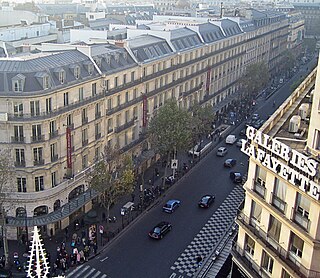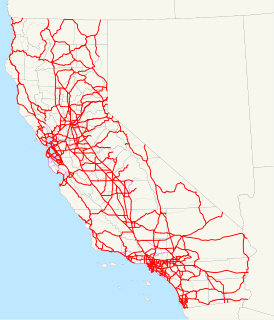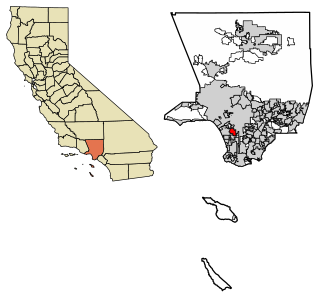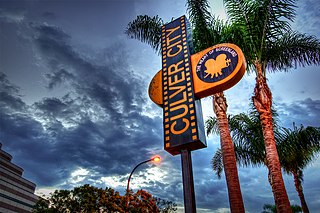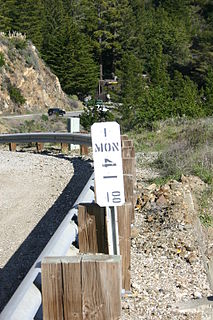
State Route 91 is a major east–west freeway located entirely within Southern California and serving several regions of the Greater Los Angeles urban area. Specifically, it currently runs from Vermont Avenue in Gardena, just west of the junction with the Harbor Freeway, east to Riverside at the junction with the Pomona, and Moreno Valley freeways.

State Route 22 in the U.S. state of California is an east–west highway in southern Los Angeles County and northern Orange County. It runs between Long Beach and Orange by way of Garden Grove. The westernmost part of it is a surface street, Long Beach's 7th Street. From West Garden Grove to its eastern terminus in Orange, it is known as the Garden Grove Freeway. It is one of the two principal east–west routes in Orange County.
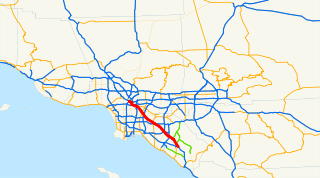
The Santa Ana Freeway is one of the principal freeways in Southern California, connecting Los Angeles and its southeastern suburbs including the freeway's namesake, the city of Santa Ana. The freeway begins at its junction with the San Diego Freeway, called the El Toro Y, in Irvine, signed as I-5. From there, it generally goes southeast to northwest to the East Los Angeles Interchange, where it takes the designation of U.S. Route 101 (US 101). It then proceeds 2.95 miles (4.75 km) northwest to the Four Level Interchange in downtown Los Angeles. Formerly, the entirety of the route was marked as US 101 until the 1964 highway renumbering, which truncated US 101 to the East Los Angeles Interchange and designated the rest of the freeway as I-5.

The Ventura Freeway is a freeway in southern California, United States, running from the Santa Barbara/Ventura county line to Pasadena in Los Angeles County. It is the principal east-west route through Ventura County and in the southern San Fernando Valley in Los Angeles County. From the Santa Barbara County line to its intersection with the Hollywood Freeway in the southeastern San Fernando Valley in Los Angeles, it is signed as U.S. Route 101, which was built in the late 1950s and opened on April 5, 1960. East of the Hollywood Freeway intersection, it is signed as State Route 134 which was built by 1971. The entire Ventura Freeway is not built to freeway standards, however; the segment that runs through the coastal communities of La Conchita and Mussel Shoals in western Ventura County still remains an expressway.
Interstate 105 (I-105) is an Interstate Highway in southern Los Angeles County, California that runs east–west from near the Los Angeles International Airport (LAX) to Norwalk. It is officially known as the Glenn Anderson Freeway for the Democratic California politician who advocated its construction. I-105 has also been referred to as the Century Freeway.

State Route 238 is a north–south highway in the U.S. state of California. The route is a divided multilane surface highway in the southeastern part of the San Francisco Bay Area. SR 238 connects Interstate 580 in Hayward and Interstate 680 in Fremont.

State Route 92 is an east-west highway in the San Francisco Bay area between Half Moon Bay near the coast in the west and downtown Hayward at its junction with State Route 238 and State Route 185. It is most notable for being the route that traverses the San Mateo Bridge. It has interchanges with three freeways: Interstate 280, U.S. Route 101 in or near San Mateo, and Interstate 880. It also connects indirectly to Interstates 238 and 580 by way of Hayward's Foothill Boulevard, which carries Route 238 and flows directly into Route 92.

State Route 60 is an east-west state highway in the U.S. state of California. It runs from the East Los Angeles Interchange near downtown Los Angeles to an interchange with Interstate 10 (I-10) in Beaumont. The highway serves the cities and communities on the eastern side of the Los Angeles metropolitan area and runs along the south side of the San Gabriel Valley. The highway provides a route across several spurs of the Peninsular Ranges, linking the Los Angeles Basin with the Pomona Valley and San Gabriel Valley. It runs from the East Los Angeles Interchange near the Los Angeles River in Los Angeles with Interstate 5 (I-5), Interstate 10 (I-10) and U.S. Route 101 east to I-10 in Riverside County, with overlaps at State Route 57 and Interstate 215. The highway runs roughly parallel to Interstate 10, functioning as a bypass alternate route east-west route through the area.

State Route 2 is a state highway in the U.S. state of California. Officially, it begins at the intersection of Centinela Avenue in the City of Los Angeles limits adjacent to the city of Santa Monica and extends all the way to SR 138 east of Wrightwood. The highway currently is divided into three segments, briefly runs concurrent with U.S. Route 101 and Interstate 210 (I-210) to connect the segments. The western section of the highway is an old routing of U.S. Route 66; the eastern portion is known as the Angeles Crest Highway, while the middle section is known as the Glendale Freeway along with multiple surface streets around Route 101.

State Route 72 is a state highway in the U.S. state of California. The route runs along Whittier Boulevard from I-605 in Whittier to SR-39 in La Habra. SR 72 forms part of El Camino Real.
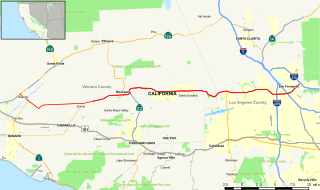
State Route 118 is a state highway in the U.S. state of California that begins running west to east through Ventura and Los Angeles counties in southern California. It travels from the eastern edge of Ventura immediately northwest of Saticoy, then through Saticoy, in Ventura County east to Lake View Terrace in Los Angeles. Route 118 crosses the Santa Susana Pass and the northern rim of the San Fernando Valley along its route.

State Route 71, the Chino Valley Freeway and the Corona Freeway, formerly the Corona Expressway and before then the Temescal Freeway, is a freeway of about 15 miles (24 km) in length located entirely within Southern California, United States.

State Route 19, also known as Lakewood Boulevard and Rosemead Boulevard, is a state highway in the Los Angeles area of the U.S. state of California. The route is a north–south four-to-six lane suburban roadway, lying between the Long Beach Freeway (I-710) and San Gabriel River Freeway (I-605), and connecting the eastern parts of Long Beach and Pasadena via the Whittier Narrows. Since 1998, several pieces have been relinquished to local governments, and more transfers are authorized by state law. The portion of SR 19 north of the Whittier Narrows is officially State Route 164, once planned to be upgraded as the Rio Hondo Freeway, but has always been signed as part of SR 19.

State Route 90 is a state highway in Southern California, United States. It consists of two unconnected pieces in Greater Los Angeles.

State Route 66 is a state highway in the U.S. state of California, running along the section of old U.S. Route 66 in California from La Verne east to San Bernardino, passing through Claremont, Upland, Rancho Cucamonga, Fontana and Rialto along Foothill Boulevard. In San Bernardino, it is the part of Fifth Street west of H Street.

State Route 27 is a state highway in the U.S. state of California that runs from Pacific Coast Highway (PCH) at Topanga State Beach near Pacific Palisades, through Topanga Canyon including the community of Fernwood Pacific also known as Topanga, and continuing through Woodland Hills, Canoga Park, West Hills, and Chatsworth to Ronald Reagan Freeway. The entire route is commonly known by its street name, Topanga Canyon Boulevard.
State Route 103, part of the Terminal Island Freeway, is a short state highway in Los Angeles and Long Beach. It runs from a split with State Route 47 northeast to a cloverleaf interchange with State Route 1. Beyond SR 1, the freeway is not State Route 103 but is technically known as State Route 103U, wherein the “U” stands for “unrelinquished,” due to the fact that the route north of Route 1 is not defined as part of Route 103 but formerly was, and when the route was truncated no legislation has been passed by the state legislature to hand over ownership of such portion of the route to the City of Long Beach. South of the end of SR 103, the Terminal Island Freeway runs south with SR 47 over the Commodore Schuyler F. Heim Bridge to its end at Ocean Boulevard on Terminal Island, at the former Long Beach Naval Shipyard. SR 47 turns west there to its end at Interstate 110.

State Route 42 is a decommissioned state highway in southern region of the U.S. state of California, running along Manchester Avenue, Manchester Boulevard and Firestone Boulevard in Los Angeles and the cities south of it. After 1968, it ran from State Route 1 west of Inglewood east to Interstate 5 in Norwalk. Though signed as SR 42, it was officially Route 105 until replaced by the parallel Interstate 105 October 14, 1993. The entire route was deleted from the California Freeway and Expressway System in 2000, with the remaining portion of SR 42 being relinquished to local jurisdictions in that year, but the route is still signed off as SR 42.

California State Route 187 in Los Angeles is the portion of Venice Boulevard between Lincoln Boulevard in Venice and its intersection with Interstate 10 in the South Robertson district.

State Route 213 is a state highway in the U.S. state of California, in Los Angeles County. The California Legislature has designated the route as Western Avenue from 25th Street in San Pedro north to the San Diego Freeway. From 25th Street to Carson Street, the California Transportation Commission has adopted Western Avenue as a State highway; however, the northerly two miles from Carson Street to Interstate 405 in Torrance has not, as yet, been adopted and remains a city street. Beyond Interstate 405, Western Avenue, continues through Torrance, Gardena, and Los Angeles to Los Feliz Boulevard in Hollywood as a city street.

